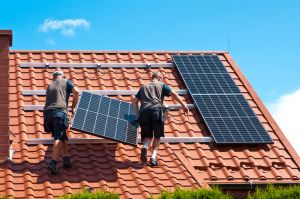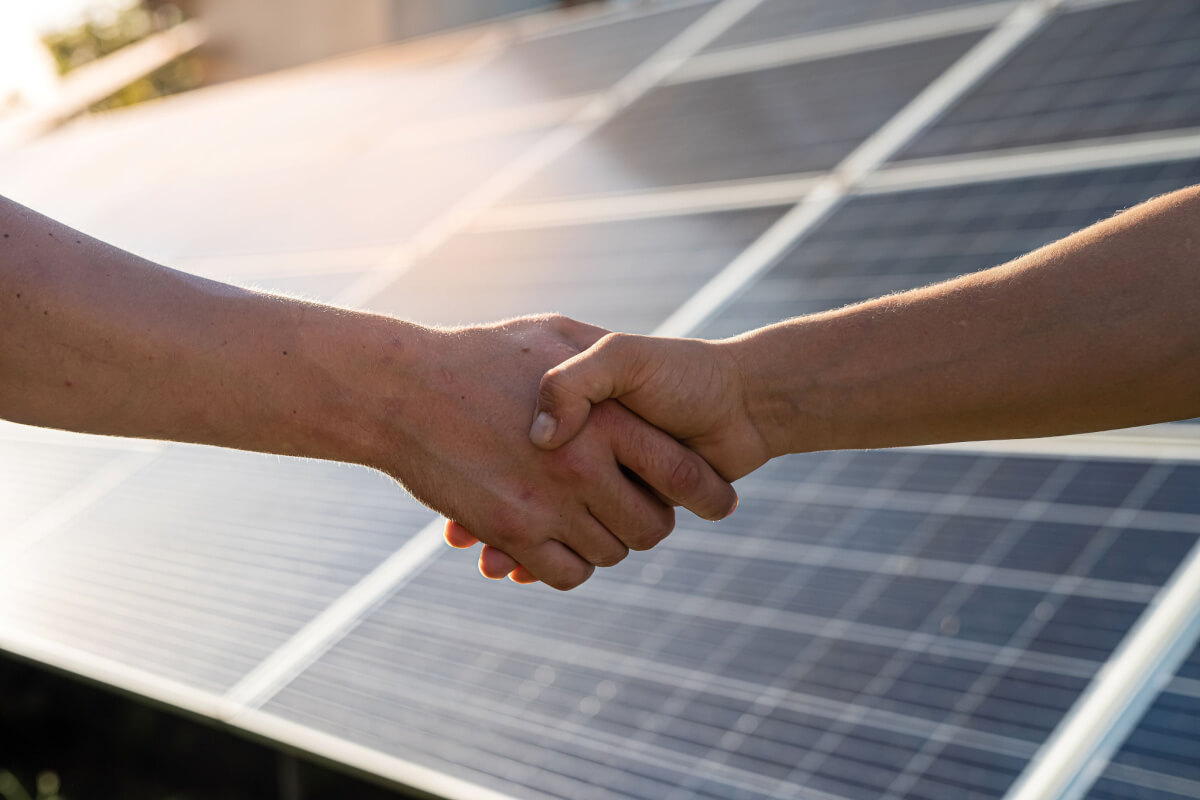Aussie homes are leading the country’s renewable energy charge. According to the Clean Energy Council, rooftop solar capacity soared by 2.7 gigawatts in 2022, making it the top contributor to Australia’s clean energy growth. But unfortunately, it often comes with a hefty price tag. If you’re looking to install solar but don’t have the funds to purchase a system upfront, a solar PPA might be an option for you. If you have no idea what that is, then you’re in the right place — this guide contains everything you need to know about solar PPAs.
On this page:
- What is a Solar Power Purchase Agreement?
- How does a solar PPA work?
- What are the benefits of getting a solar PPA?
- Who is eligible for a solar PPA?
- What to consider before signing a PPA
- What’s cheaper: A solar PPA or purchasing a system outright?
- What is the difference between a solar PPA and a solar lease?
- Should I get a solar PPA?
Advertisement
What is a Solar Power Purchase Agreement?
A Power Purchase Agreement (PPA) is an arrangement where a solar service provider designs, builds, owns, operates, monitors and maintains a photovoltaic (PV) solar system and a customer agrees to house the system on their roof or elsewhere on their property. There are usually no upfront costs involved for customers on a PPA and the contract term can last anywhere from five to 25 years, depending on the provider.
Based on the terms of the agreement, the customer may own the system or be able to purchase the system outright at a discounted price after the terms of the agreement have come to an end. Some agreements may even allow customers to keep the system for free afterwards.
How does a solar PPA work?
A solar PPA works in a similar fashion to normal solar system generation in the home, however, instead of using the generated solar energy for free, you’ll pay the provider you have the PPA with for this power. This is at a fixed or negotiated price for each kilowatt hour (kWh) generated and usually lower than average market prices. By charging you for the solar energy generated, the provider is able to cover the costs of the system on loan to you.
A grid connection is still necessary for households and businesses with a solar PPA to cover any electricity usage during times when the solar panels aren’t generating energy (for example, overnight). This means you’ll receive two energy bills — one that accounts for any electricity used from the grid and another for the solar energy used.
Excess energy from a system under a solar PPA can also be sold back to the electricity grid. Depending on the agreement in place, however, the credit or solar feed-in tariff for these exports may go directly to the provider you have an agreement with instead of you.
To make the most of your solar energy on a PPA, it might help to shift the usage times of your biggest energy-sucking appliances, such as washing machines and clothes dryers, to daytime hours.
What are the benefits of getting a solar PPA?

Solar PPAs can be an excellent way to access solar energy without the financial hurdle. Some of the key benefits of a solar PPA agreement include:
- no large upfront costs to purchase a solar PV system;
- lower energy costs locked in for the term of the agreement;
- provider-managed ongoing maintenance and repairs;
- the option to buy out the solar power system, depending on terms and conditions; and
- a reduced carbon footprint.
You may also get access to energy monitoring and historical data as part of your PPA and, depending on the provider, be able to incorporate battery storage into the agreement at a later date. This would allow electricity generated by the system to be stored and used at night.
Who is eligible for a solar PPA?
Most properties, both residential and commercial, are eligible for a solar PPA, so long as the property’s rooftop meets the requirements of the agreement. These criteria will differ in each agreement, however, a requirement for most is that the rooftop doesn’t already have solar panels and there are no obstructions, such as trees, in the way of the rooftop.
You might also be interested in:
What to consider before getting a PPA
If you’re considering an agreement, make sure to read the contract carefully so you know what your rights are, and seek legal advice if necessary. It is important that before you sign anything, you’re aware of exactly what you’re getting yourself into.
Some of the things you should confirm with your agreement providers before signing include:
- The price, per kWh, you’ll be charged for the solar energy used.
- Whether you’ll need to pay for all the electricity generated from the system or just the energy you used.
- Who gets the credits for sending excess solar back to the grid?
- What events or damages are covered by the insurance for the system (e.g. storms)?
- What happens if you leave the agreement early — will you need to buy the system outright?
- When the agreement is over what happens to the system?
- Are there any other costs involved with installing the system?
Most PPAs can range from five to 25 years, so understanding what you might be locked into during this time is vital.
Compare Solar Plans
Here are some of the cheapest solar-specific deals from the retailers on our database. These costs are based on the Ausgrid network in Sydney but prices will vary depending on your circumstances. We show one product per retailer, listed in order of lowest price first. Annual price estimates assume general energy usage of 3900kWh/year for a residential customer on a single rate tariff. Price estimates exclude solar feed-in tariff credits. These are products from referral partners†. Our database may not cover all deals in your area, and please check retailer websites for up to date information.
Here are some of the cheapest solar-specific deals from the retailers on our database. These costs are based on the Citipower network in Melbourne but prices will vary depending on your circumstances. We show one product per retailer, listed in order of lowest price first. Annual price estimates assume general energy usage of 4000kWh/year for a residential customer on a single rate tariff. Price estimates exclude solar feed-in tariff credits. These are products from referral partners†. Our database may not cover all deals in your area, and please check retailer websites for up to date information.
Here are some of the cheapest solar-specific deals from the retailers on our database. These costs are based on the Energex network in Brisbane but prices will vary depending on your circumstances. We show one product per retailer, listed in order of lowest price first. Annual price estimates assume general energy usage of 4600kWh/year for a residential customer on a single rate tariff. Price estimates exclude solar feed-in tariff credits. These are products from referral partners†. Our database may not cover all deals in your area, and please check retailer websites for up to date information.
Here are some of the cheapest solar-specific deals from the retailers on our database. These costs are based on SA Power network in Adelaide but prices will vary depending on your circumstances. We show one product per retailer, listed in order of lowest price first. Annual price estimates assume general energy usage of 4000kWh/year for a residential customer on a single rate tariff. Price estimates exclude solar feed-in tariff credits. These are products from referral partners†. Our database may not cover all deals in your area, and please check retailer websites for up to date information.
What’s cheaper: A solar PPA or purchasing a system outright?
The cost value of a solar PPA will ultimately come down to the personal energy habits and needs of the property. However, in some cases it may be possible that entering a PPA will cost more than purchasing a solar system outright. This is because, even though there is a $0 upfront payment, there may be various other costs associated, such as installing new electricity meters, additional insurance policies or structural changes to the property to prepare for the solar panel installation.
That’s why it is important to shop around and compare quotes from a variety of solar installers on both their system installs and PPAs before making a purchase decision. This way, you’ll be able to distinguish which option will be best for your home or business.
What is the difference between a solar PPA and a solar lease?
A solar lease is similar to a solar PPA. However, with a solar lease you’ll pay back through a predetermined payment scheme, whereas with a solar PPA you pay off the system slowly, by paying for the energy your panels produce. Solar leases are also generally held over a shorter contract period than PPAs.
Both options allow you to get a reliable renewable energy source with little to no upfront cost.
Should I get a solar PPA?
If you don’t currently have a solar power system installed in your home or business, then a solar PPA agreement might be a solid option. This is as long as you know exactly what you’re getting yourself into — the terms of the contract and the process for early termination, for example.
Keep in mind that a solar PPA may work out more expensive over the term of the agreement than purchasing a system upfront. That’s why it is important to compare quotes that take your energy usage habits into account before making a purchase decision.
If you’re interested in installing a solar power system in your home or business, be sure to check out our annual solar installer ratings. Our report lists which installers Aussie consumers rate highly based on their customer service, solar system performance, installation process, durability and set-up costs.
Best-Rated Solar Panel Installers
Image credit: RomanR/Shutterstock.com, AHatmaker/Shuttershock.com




Share this article